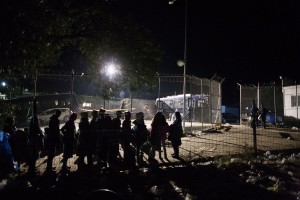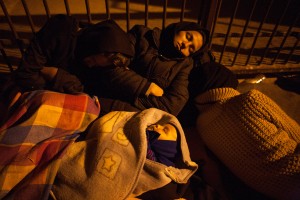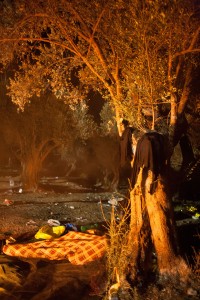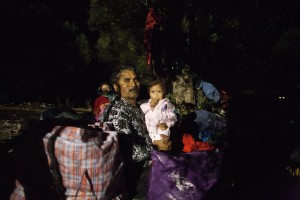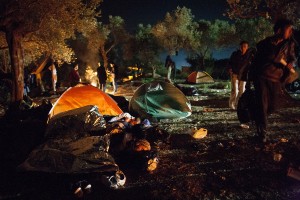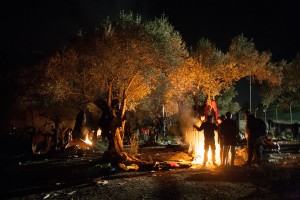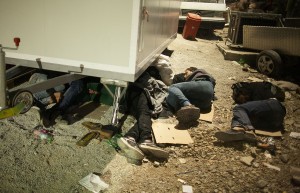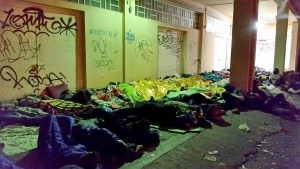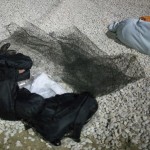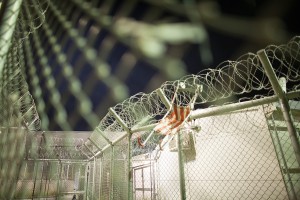
A buggy is hanging on the barbed wire of Morias’ “First Reception Centre” / copyright: Salinia Stroux
Concurring the Hot Spots the open question is, what will happen to the remaining nationalities entering these centers. In the light of the secret plans of the EU recently uncovered by the Times it is to be feared that many thousands will be in danger of deportations.
On Saturday the UN refugee agency chief Antonio Guterres during his visit on Lesbos, met the island’s mayor and inspected the two refugee camps Kara Tepe and Moria. According to the UN Commissioner the Hot Spots can only function if they provide for adequate conditions. But Moria camp which currently seems to be the only possible location is not more than an empty cage where systematic police violence is applied any time numbers of refugees exceed the manageable size. Only a few days ago and before Syrians were added to the population dealt with in Moria, riot police was repressing the desperate tries of refugees to enter registration procedures with tear gas and beatings. Many of the victims were small children. Only after fast track registration procedures were implemented again (as in the period in the beginning of September where high numbers of arrivals had lead to escalating violence), numbers of unregistered newcomers waiting for their papers decreased quickly. Anyhow, this is most likely only a short term solution for emergency situations as the EU presses for upholding the standards in the Eurodac-data collection and completing registration procedures in the first hand. Since Friday October 9, when Syrian refugees were moved to Moria, they receive a registration number upon entering the main gate and then have to wait in a small crowd in front of the so called First Reception Centres’ gates for their turn. Inside the gate people are waiting in a fenced yard to enter further into the areal. Every time the inside gate opens some families are pushing to enter raising their childs in the air. “Malakes! You know what it means Malakes?” A young man in plain clothes is shouting on the refugees. “Fuck you! Asshole!” he continues shouting on the exhausted refugees while trying to control who enters.With the closure of Kara Tepe, suddenly some measures have been taken to improve infrastructures in Moria. Yet any form of stay there is unbearable. Many Syrians sleep in a huge UNHCR tent like sardines one on top of the other. Most families lack blankets. Hundreds sleep outside in the dust, while their clothes are still wet: Babies, elderly, victims of torture, handicapped alike. They are hungry and thirsty. Catering services which were halted in October 18, as the government could not solve the issue of the unclear status of the camps, are still not provided for by the authorities. The police still owes 6 Million Euro for meals already provided by different companies in the past. Solidarity groups together with NGOs try to cover this gap currently offering one meal a day. Anyway, many people arrive after the meals are distributed or leave before, so they would stay often for 1-1 ½ days without any food and clean drinking water. At the meantime all Non-Syrians have to queue on the back gate, standing outside of Moria on a muddy street. The two lines separate families and single men. Two busses of riot police stand in the yard near the gate. An Afghan family with three toddlers camping only five meters away on an olive field is sitting on the earth. It is after 2 o’clock in the morning. A father belonging to the group reports of the rude behavior of the officers he witnessed that day: “We stayed three hours in the queue. While we were waiting one of the officers – the one with long hair – was pushing around women and men. He even slapped one woman.” The Non-Syrians have been technically expulsed from the inside of Moria thus losing access to the UNHCR tents (which do not suffice anyway for all those refugees), the mobile traders offering blankets, tents, food and drinks (which most of them can’t afford anyway) and the toilettes and showers (a filthy place where lights are not working). The clear spatial separation implemented since Saturday brings also another clear discrimination in access to services and to the insufficient but at least existing somehow infrastructures. At the main gates police officers control that Non-Syrians don’t enter. This decision has forced the affected refugees do sleep rough in olive fields near their registration gate and in the port of Mytilene in a period of time where weather conditions are getting worse and rainfalls make any form of sleeping rough difficult if not impossible. Ideally, the mayor of Mytilene Mr. Ghalinos and the UN High Commissioner would anyway prefer the Hot Spot to be located in the North of the island, but the locals are resisting to this idea since it was first expressed. On Friday 9th, a plenary of inhabitants from Molyvos and Petra in the North of the island once more underlined their decision not to permit the creation of a “Hot Spot” in their region, which according to them is receiving 80% of the islands tourism.
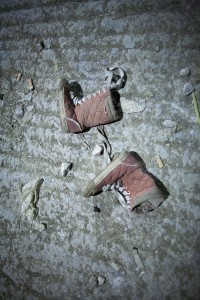
Many children sleep outside in the fields, on the dusty ground or the cement floor / copyright: Salinia Stroux
Whatever might happen in future, it is clear is, that the planned Hot Spots will bring new problems to refugees arriving in Europe and that the ideal place for refugees is certainly not and will never be Moria. What is going on there is a shame for humanity.
EPILOGUEAnd then in the early morning hours it starts to rain. There are about 300 persons sleeping without tents in the port – many even without blankets and some hundreds sleeping unprotected in the outside area of Moria. …
all photos copyright: Salinia Stroux
